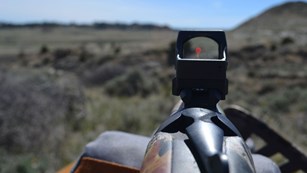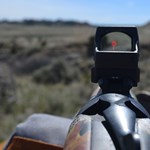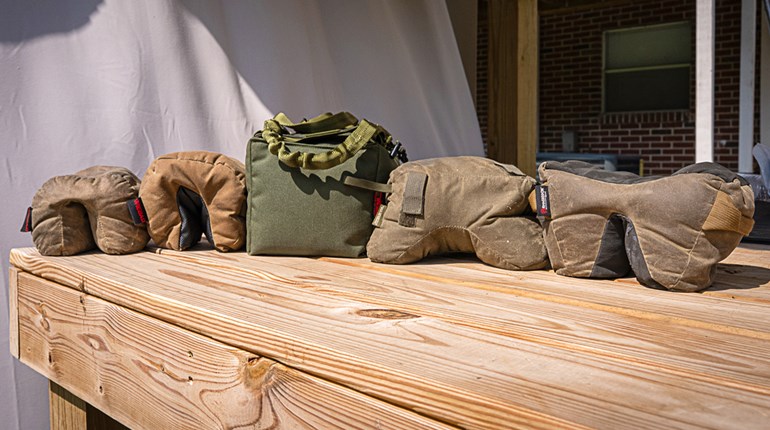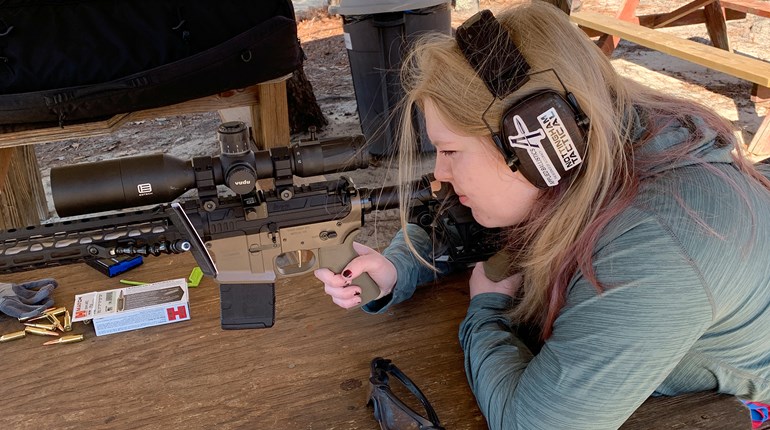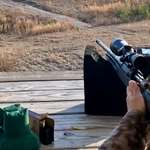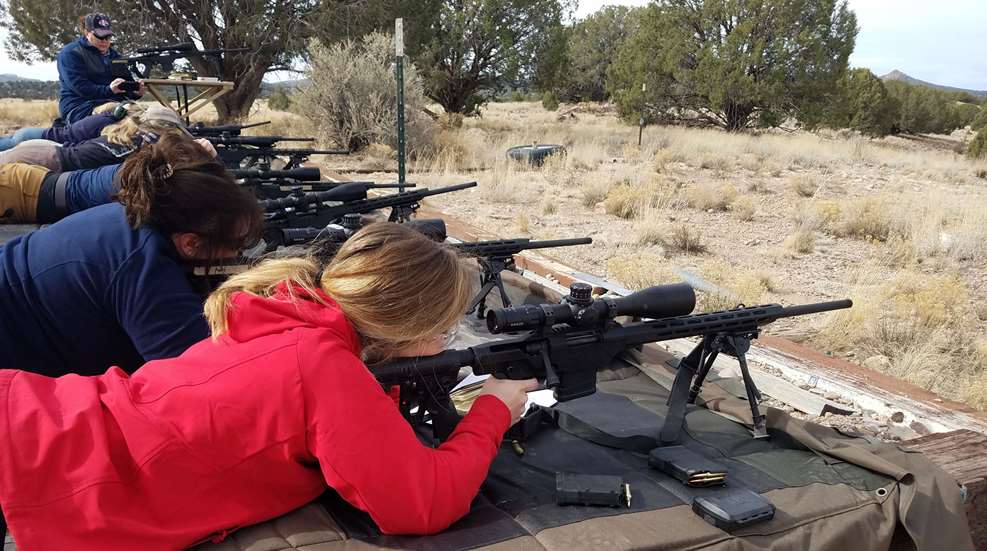
Precision shooting, particularly at ranges approaching 1,000 yards and beyond, is a game of details. Everything has to go right in order to hit your intended target at that kind of distance, and a dozen or more variables come into play.

If you’ve been stretching out your distance at the range but having trouble getting good, consistent hits, several things could be to blame. Assuming your gun is capable of MOA accuracy (at least) and your elevation is dialed correctly, here are four of the most common problems you could be experiencing with your precision shooting.
1. Your Form Is Off
Proper form is important for accurate shooting at any range, but the farther out you go, the more critical it becomes, and minor flaws in your setup will be exponentially magnified as the distance increases.
Every minor movement of your body will transfer to the gun, so you need the most stable shooting platform available—that means you’re either going prone or setting up on a bench with a steady front and rear rest. Both will work, but I prefer prone for long-distance shooting. Although it’s not the most comfortable position if you’re not accustomed to it, it is the most stable because so much of your body is in contact with the ground.
Using a front and a rear rest (which can be your hand if you prefer) to support the gun, lie down behind the rifle so that the barrel is in line with your spine. Spread your legs out as far as is comfortable and point your toes out so that the sides of your feet are flat on the ground. When you’re comfortable behind the rifle and are looking through the scope at the target, close your eyes. Take a deep breath or two and open your eyes again. If you can still see the target in your crosshairs, you’re good to go. You’ve found your natural point of aim, which means you probably aren’t holding muscle tension in your body that could affect your shot. If you can’t see the target, move yourself (not the gun) and try again. Repeat as many times as is necessary.

2. Your Trigger Pull Is Sloppy
When you’ve found your natural point of aim and you’re ready to shoot, the only muscle you should move is your trigger finger. You want to pull the trigger the same way every time for consistent results. A proper trigger pull is a deliberate, smooth squeeze using the first pad of your finger—try not to nestle the trigger in the joint behind the first pad. Don’t try to take a deep breath and let it out slowly or any of that nonsense. Just breathe normally and squeeze the trigger at your natural respiratory break—after you’ve let a breath out but before your body has started to inhale for the next breath. If you’re forcing yourself to breathe abnormally slowly in order to pull this off, you’re taking too long to make a decision and squeeze the trigger. Don’t rush it, but don’t take so long that your lungs start asking for air.
Pull the trigger straight back with a consistent amount of pressure. If the trigger is any good, which it almost certainly will be on a gun that’s capable of shooting 1,000 yards, it shouldn’t require a lot of pressure. Don’t hurry, but don’t take too long to execute a trigger squeeze or your brain will start thinking, “Oh my gosh, when is it going to fire … is it now? Is it now? Why hasn’t it gone off yet? It must be about to happen … ” and you’ll flinch.
Whatever you do, don’t jerk the trigger, which sometimes happens if you’re anticipating the noise or the recoil of the gun. Jerking the trigger—squeezing it too quickly and usually pulling it to one side or the other instead of straight back—can move the entire gun while the projectile is still traveling down the barrel, sending your shot off course.
Keep the trigger pressed to the rear for a moment after the gun fires. This helps prevent that gun movement and promotes good follow-through.
3. Your Gun and Ammo Don’t Get Along
Not all guns like all loads or all brands of ammo, and sometimes there’s frustratingly little explanation for it. The only real way to find out is to buy several different brands and shoot them to see what loads are the most accurate out of your particular gun. You can shorten the curve a little by buying match-grade ammo, which is just a label that means the ammo is highly consistent from cartridge to cartridge. It’s typically made with competition shooting in mind, manufactured to tight tolerances.

Properly fired bullets spiral in the air, which makes their flight path stable and predictable. Every rifled barrel has a particular twist rate, which is a measure of how tight or loose the rifling is. A rifle with a 1:8 twist will fully rotate the launched projectile one time in eight inches. The lower that number, the faster the bullet will spin. Though rifle manufacturers optimize the twist rate to suit the most common and widest range of suitable projectiles, if you have bought ammo loaded with an unusually heavy or light bullet or if your rifle has an unusually fast or slow twist rate that’s not as common for that caliber, you can have problems with the bullet rotating too quickly or too slowly. This destabilizes the bullet, disrupting that spiral and causing the bullet to tumble. When that happens, accuracy is out the window. A telltale sign that your bullet is destabilized is that instead of punching clean, round holes in paper targets, it will rip jagged lines because the bullet is striking the paper sideways. If this is happening to you, look into matching your rifle’s twist rate with your projectiles. You can start by trying a load with a heavier bullet.
This isn’t often a problem with modern guns and modern, match-grade ammo, but it’s worth knowing. Generally speaking, slower rifling (higher numbers) goes better with lighter bullets, and faster rifling goes better with heavier bullets.
4. Your Wind Reading Needs Work
If you know you’re a good shooter with solid form and a consistent trigger pull and you know your gun/ammo combination shoots accurately, but you’re still missing left or right, it’s almost certainly a wind problem. Reading the wind is an acquired skill that takes a whole lot of practice to master, and the farther out you’re shooting, the more complicated it gets. Wind pushes bullets around, and you must learn to compensate for it if you hope to get hits on target at long ranges.
Understand that although the wind is blowing right-to-left at your shooting position, it could be doing something dramatically different at the target—and at several spots in between. If you’re at a shooting range, they likely have flags at set distances that you can use to gauge the wind. Without flags, you can watch the direction in which trees or grass are blowing, and particularly if it’s a hot day, you might be able to see mirage, which looks like vertical heat waves that will “blow” left or right, through your scope. If your bullet misses its target, you’ll likely be able to see the splash in the dirt, so watch which way that dust drifts and how fast it goes.
The only way to get better at reading wind is to do a lot of it, and you should shoot in wind as often as you can so you get a feel for how far left or right to hold based on how hard you think the wind is blowing. For a while, you’ll just be “walking it in”—that is, you’ll miss one way or another and hold a little differently next time, adjusting each shot until you hit. Of course, this gets trickier if the wind is gusty. But with plenty of practice paying close attention to how wind affects your bullet’s trajectory, you’ll be back on target.
